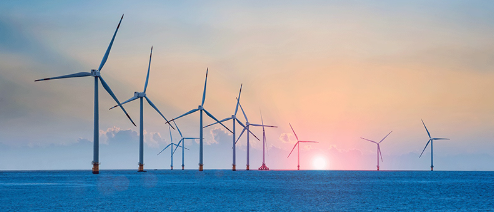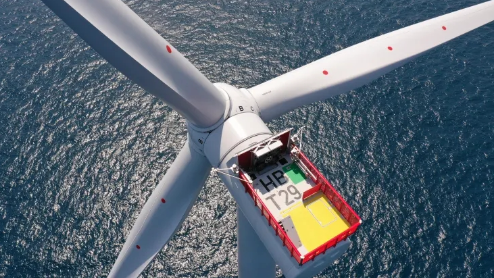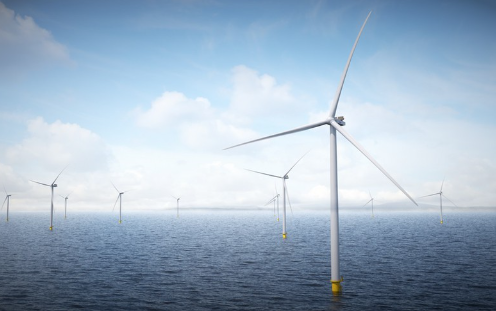Wind power is the leader in building the new power system in the future, and it is also the principal force to achieve carbon peak and carbon neutral power. With the development of land wind energy resources exhausted, capital is also pushing the wind power industry to seek additional wind energy. Why is offshore wind so prevalent?

Offshore wind power is the energy extracted from the power of offshore wind, converted into electricity and supplied to the onshore grid.
Offshore wind power is a continuously renewable and unlimited source of energy, and converting wind power into electricity does not result in harmful greenhouse gas emissions. Offshore wind will play an important role in our future power generation as we work to tackle climate change and reduce greenhouse gas.
According to the latest energy trends data from the Department of Business, Energy and Industrial Strategy (BEIS), the share of offshore wind increased from 9.7 per cent in the third quarter of 2019 to 11 per cent in the third quarter of 2020. That compares with 5.6 percent for solar energy and 12.7 percent for bioenergy and waste.
The highest record for wind generation in 2020 was broken several times during the year, most recently on 18 December (17.2GW), while the contribution of wind generation to the electricity mix reached its highest share ever on 26 August (59.9%).
The UK has the largest installed offshore wind capacity in the world, with around 10GW operating off its coast. The North Sea is regarded as the engine room of the UK's green and resilient future economy and is a world leader in offshore wind technology.
Germany is the one with the second-largest cumulative installed offshore wind capacity, followed by China.
Hornsea 1 in the North Sea is the most important thing offshore wind farm in the world. Off the Lincolnshire coast, it has 174 turbines covering 407 square kilometres, providing 1.2GW of green energy. That's enough to power more than a million homes from sustainable sources.

The UK and its European neighbours have been working to develop green clean electricity from offshore wind farms. And there are planned to increase offshore wind power. The government has set an ambitious target of deploying 40GW of offshore wind by 2030. Four times the 10GW we currently produce and enough to power every home at current levels of electricity consumption.
The Committee on Climate Change has recommended that 140GW is needed to reach net zero by 2050. Demand will increase as we shift to clean energy to power our electric cars, heat our homes and power our energy-intensive industries, such as data centres.
South Korean President Moon Jae-in says his country will build the world's largest offshore floating wind farm, calling it one of the cornerstones of developing clean energy.

The cost of the program has been pegged at $32 billion.
The wind farm will be built in water near Ulsan, an industrial city in southeastern South Korea. The plan is to create 6 gigawatts of electricity, enough to power 5.8 million homes.
The project will be expected to be completed by 2030 and is expected to create 210,000 jobs.
"Offshore wind power is like a carbon-free oil resource for the 21st century," Moon said in Ulsan on May 5.
And Denmark's Vestas said it has been selected as the preferred turbine supplier for the 1.2 GW Baltic Power Project, one of Poland's first offshore wind farms, which are expected to come online in 2026.
Prussian has won two major contracts worth more than €800 million, including one from Amprion Offshore GmbH, a subsidiary of German power transmission operator Amprion, for the design, supply, installation and commissioning of land and submarine cables for two grid connected Offshore wind farm systems in Germany's North Sea. DolWin4 and BorWin4.
Hornsea 2, described by Danish energy company Orsted as "the world's largest offshore wind farm", is fully operational and its 165 turbines will power more than 1.4 million UK homes.
The Hornsea 2 offshore wind farm, located about 89 kilometers off the coast of Yorkshire, England, has an installed capacity of more than 1.3 gigawatts and covers 462 square kilometers, more than half the size of New York City, depending upon the site. Hornsea 2 uses Siemens Gamesa turbines with blades 81 meters long.
"One rotation of a wind turbine blade can power the average UK home for 24 hours," it said.
European countries are trying to wean themselves off Russian demand for fossil fuel, including natural gas, in the wake of the conflict.
"Current global events highlight more than ever the importance of landmark renewable energy projects such as Hornsea 2, helping to improve the security and resilience of the UK's energy supply and reducing costs for consumers by reducing reliance on expensive fossil fuels."
The UK has a mature offshore wind industry, which continues to expand over the next few years, with authorities aiming to install 50 gigawatts of capacity by 2030.
The UK set a target of 300 gigawatts of offshore wind by mid-century before it left the European Union in January 2020.
According to Wang Dapeng, deputy director of the new energy Department of the China Energy Administration, in order to promote the high-quality development of China's offshore wind power, the future will orderly promote the layout optimization of offshore projects and far-reaching sea project pilot demonstration.
At the same time, deputy Director General Wang Dapeng also revealed that in order to promote the development of offshore wind power, the country is improving the far-reaching sea wind power industry policy, accelerate the formulation of far-reaching offshore wind power development and construction management measures.

Compared with onshore wind power, the development environment of offshore wind power is more complicated, and the construction difficulty and consumption are also more difficult. Therefore, in terms of policy support, project construction and standards, offshore wind power will form its own system.
We can clearly predict that in the policy level of developing offshore wind power, China is planning to make significant efforts to support the large-scale development and high-level consumption of offshore wind power through policies.
Offshore wind development has many advantages:
Keep a distance from local residents to eliminate concerns about noise from wind turbine blades and reduce the impact on the regional environment.
Space is to significantly increase the number of wind farms to provide clean energy to homes and businesses.
Create jobs. The government estimates that an increase in offshore wind capacity to 40 gigawatts (GW) over the same period will admit of 60,000 new jobs. Analysis in the report suggests that the country needs to fill 400,000 jobs in the energy sector over the next three years to reach net zero by 2050.
In addition to being clean and green, offshore wind is cost-effective, so electricity bills will be reduced.
Although the development of offshore wind power is a matter of more advantages than disadvantages, its shortcomings should not be ignored.
The disadvantages of offshore wind farms are:
Worrying about the impact on birds and Marine Life. Here, the influence of unchecked climate change on wildlife needs to be balanced against continued research into habitat loss, disturbance and collisions.
The Royal Society for the Protection of Birds (RSPB) acknowledges the bigger picture and says: "Switching to renewables now rather than in 10 or 20 years is vital if we are to stabilise greenhouse gases in the atmosphere at safe levels." Wind farm developers work in close cooperation with local environmental groups to negotiate the location and size of wind farms.
There are some potential disruptions in the infrastructure creation process, regardless of the fact that interconnector integration means fewer disruptions than multiple projects.
However, from the overall perspective, the development of offshore wind power is of extremely robust strategic significance for the long-term development of the country. Countries around the world have started to exploit offshore wind power because they see its potential.